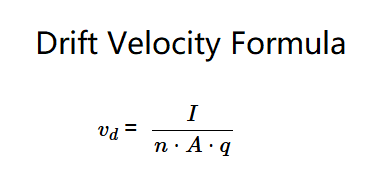 Home
Home
 Back
Back

Definition: This calculator computes the drift velocity (\(v_d\)), the average velocity of charge carriers (e.g., electrons) in a material due to an applied electric field.
Purpose: It is used in physics and electrical engineering to analyze the motion of charge carriers in conductors, helping understand electric current and material properties.
The calculator uses this formula:
Explanation: Input electric current, number density of carriers, cross-sectional area, and charge of the carrier in your chosen units. The calculator converts to base units (A, carriers/m³, m², C) and outputs drift velocity in m/s, cm/s, μm/s, and Hz.
Unit Conversions:
Details: Drift velocity is key to understanding electrical conductivity and current flow. Examples include:
Applications: Essential for electronics design, power transmission, and studying material behavior under electric fields.
Tips: Enter positive values with up to 4 decimal places and select units. Results are in m/s, cm/s, μm/s, and Hz. Values < 0.0001 use scientific notation. Avoid zero density, area, or charge.
Example: For copper with \(I = 1 \, \text{A}\), \(n = 8.5 \times 10^{28} \, \text{carriers/m}^3\), \(A = 3.14 \, \text{mm}^2\), \(q = 1.6 \times 10^{-19} \, \text{C}\):
Current Density: \(J = n \cdot q \cdot v_d\), linking drift velocity to current flow.
Electron Mobility: \(v_d = \mu \cdot E\), where \(\mu\) is mobility and \(E\) is electric field, related to drift velocity.
Thermal Velocity: Random motion of electrons (~1570 km/s in copper), contrasted with slow drift velocity.
Q: Why is drift velocity so slow compared to current speed?
A: Drift velocity (~μm/s) is slow, but the electric field propagates at nearly light speed, making current appear instantaneous due to many carriers.
Q: Can drift velocity be negative?
A: No, it’s typically positive (magnitude), but direction depends on charge carrier sign (e.g., electrons drift opposite to field).
Q: Why does the result show zero?
A: If density, area, or charge is zero, division by zero occurs, so results default to zero.
Q: Why are some results in scientific notation?
A: Values < 0.0001 are displayed as, e.g., \(1.23 \times 10^{-5}\), for clarity.
Q: What does Hz mean here?
A: Hz is included as \( v_d / 2\pi \), representing frequency (non-standard but per request), assuming a cyclical context.